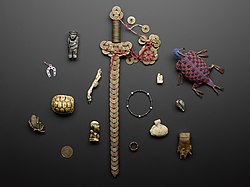File:LargeA6658400003.jpeg

Original file (1,536 × 1,151 pixels, file size: 239 KB, MIME type: image/jpeg)
Captions
Captions
Contents
Summary
Object
| Galvanic brooch
|
|||
|---|---|---|---|
| Title |
Galvanic brooch label QS:Len,"Galvanic brooch" |
||
| Collection |
|
||
| Reference URL InfoField | https://collection.sciencemuseumgroup.org.uk/objects/co139561 | ||
Photograph
| Source | Science Museum Group | ||
| Author | Science Museum Group Studio | ||
| Permission (Reusing this file) |
This file is licensed under the Creative Commons Attribution 4.0 International license.
|
||
| Collection InfoField |
|
Licensing
- You are free:
- to share – to copy, distribute and transmit the work
- to remix – to adapt the work
- Under the following conditions:
- attribution – You must give appropriate credit, provide a link to the license, and indicate if changes were made. You may do so in any reasonable manner, but not in any way that suggests the licensor endorses you or your use.
File history
Click on a date/time to view the file as it appeared at that time.
| Date/Time | Thumbnail | Dimensions | User | Comment | |
|---|---|---|---|---|---|
| current | 22:58, 28 June 2022 |  | 1,536 × 1,151 (239 KB) | Battleofalma (talk | contribs) | pattypan 22.03 |
You cannot overwrite this file.
File usage on Commons
The following page uses this file:
File usage on other wikis
The following other wikis use this file:
- Usage on www.wikidata.org
Metadata
This file contains additional information such as Exif metadata which may have been added by the digital camera, scanner, or software program used to create or digitize it. If the file has been modified from its original state, some details such as the timestamp may not fully reflect those of the original file. The timestamp is only as accurate as the clock in the camera, and it may be completely wrong.
| JPEG file comment | Group of various amulets, used to prevent/cure various diseases & ailments and bring good fortune. In the centre is a Cash sword, made up of coins, used to protect a new born baby from harmful spirits, Chinese, 1701-1800. (A642968). On the left of the sword, from top to bottom of the frame: Carved green stone amuletic figure, said to be invoked for stomach pains, slightly chipped, from Middle East, 1701-1910. (A156286), Small steel model of a horseshoe, made in Paris, France, 1890-1930. (A665840), Rabbit's foot, dried sinewy flesh over bone, carried by an old man as protection against rheumatism, Suffolk, England 1860-1905. (A176531), Small yellow and brown tortoise carapace used as amulet, Palestinian, 1880-1930. (A665312), Dried frog, used to cure toothache, being hung round neck, European, 1890-1930. (A630920), This small ivory figure is attributed to the Bahuana people of the Democratic Republic of Congo in central Africa. It shows a woman in labour covering her ears with her hands. It is thought to be a protective amulet for women in childbirth, a time when both mother and baby are at risk. (A658228), and a Galvanic brooch, brass, possibly charm against toothache, by Castella, Paris, French, 1880-1920. Inscribed on 'Plaques Galvaniques Electriques de Colombet Abeziers' (A602790). On the right of the sword from top to bottom of the frame: Buckskin amulet, in the form of a tortoise, likely to contain umbilical cord, decorated with bead-work Sioux, U.S.A.(A190725), Stone amulet, of man and woman embracing said to promote domestic felicity, from upper plateau of Andean Cordillevas, Bolivan, 1800-1900. (A669594), Bronze pendant amuletic, shaped like cowrie shell, probably erotic symbol, in display box with others, probably Roman, from Italy, 200BC -200AD. (A67802), Amuletic bracelet of twisted wire and blue and brown beads, said to bring luck and ward of rheumatism, South African, 1880-1925 (A160806), Small muslin bag containing crust of bread, amuletic, to ward off toothache, Lovett collection, from London, English, 1901-1913. (A659967), Ring made from penny by old sailor, amulet protecting against rheumatism, Lovett collection, from Scarborough, English, 1901-1913. (A132563) and an Otter's paw, mounted as a brooch, said to be Elizabethan, from the 17th century museum collection of Sir Vanhattem of Dinton Hall, Buckinghamshire, English, 1580-1650.(A71953). |
|---|


